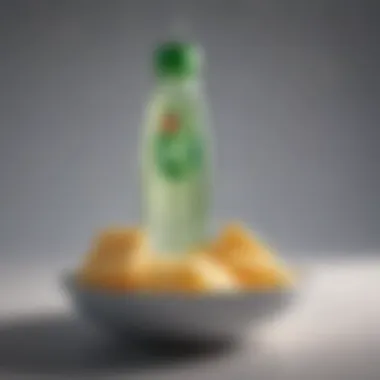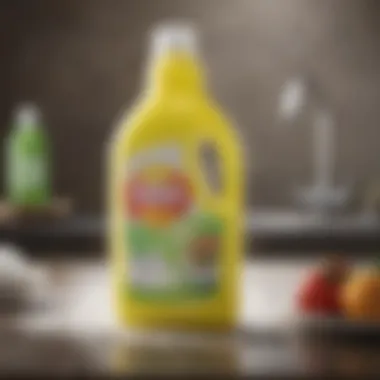Understanding Dish Detergent: Composition and Sustainability


Intro
Dish detergent plays an essential role in the lives of many people around the world. As an everyday product in most kitchens, it is overlooked often, despite its importance. Understanding dish detergent involves exploring its composition, how it is used, and its implications for the environment. Each aspect can inform better choices for wellness at home and sustainable practices.
Composition of Dish Detergent
Dish detergent is primarily made of surfactants, which are compounds that lower the surface tension of water. This property allows the detergent to effectively bind with grease and food particles, allowing for better cleaning results. Other ingredients found in dish detergents include:
- Enzymes: Help to break down food particles more efficiently
- Fragrances: Provide pleasant scents but can cause allergies or sensitivities
- Preservatives: Extend the product's shelf life
- Thickeners: Adjust the viscosity for usability
Each ingredient serves a purpose, making them all significant to the detergent's overall efficiency.
Usage Methods
Using dish detergent may seem straightforward, but various methods can optimize its efficacy. One common approach is:
- Rinse dishes to remove excess food waste.
- Apply a small amount of detergent to a sponge or cloth.
- Scrub each piece thoroughly, ensuring that hard-to-reach areas are not neglected.
- Rinse with warm water to remove all detergent residues.
It is recommended to follow manufacturer instructions as concentrations can vary across different brands and types of dish detergent.
Carful Selection
When selecting a dish detergent, consider factors like an environmental impact and any specific allergies to fragrances or ingredients. Certain brands have committed to more sustainable practices, utilizing plant-based ingredients and biodegradable surfactants.
Environmental Impact
Dish detergents can contribute to pollution when washed down the drain. Chemical residues from certain products can harm aquatic life. It’s essential to pay attention to ingredients and choose products that do not have harmful effects on ecosystems but also clean effectively.
Making Sustainable Choices
Choosing eco-friendly dish detergent brands is now a popular choice among conscious consumers. These brands generally prioritize:
- Biodegradable ingredients
- Minimalistic packaging inspired by a less wasteful mindset
- Transparency about the sourcing and manufacturing process
Moreover, consider purchasing concentrated formulas to manage waste more efficiently as well.
Epilogue
Understanding dish detergent entails more than simple usage. The composition and sustainable options show a deep connection to daily practices and broader ecological awareness. Taking steps to select wisely can lead to both enhanced cleaning in our homes and a positive impact on the environment.
Prelims to Dish Detergent
Dish detergent plays a vital role in most kitchens, delivering hygiene and cleanliness. Its effectiveness can influence the eating experience and contribute to health safety. Understanding why dish detergent is deemed necessary involves looking into its definition, historical significance, and ongoing improvements in formulations. People should see dish detergent as more than just a product to scrub dishes. This introductory examination aims to unearth these layers and challenge preconceived notions.
Definition and Purpose
Dish detergent is a specialized cleaning agent intended for dishware and utensils. It is chemically designed to remove food particles and grease. By breaking down oils and allowing for easier rinsing, it aids in ensuring a clean kitchen environment. Modern formulations often consider both effectiveness in cleaning and care for the user and surroundings. Thus, using an appropriate dish detergent is crucial for maintaining cleanliness and safety.
Key Functions:
- Cleaning: The primary focus is to cleanse dishes and remove residues.
- Grease Breakdown: Helps dissolve oils and fats often stubborn post-meal.
- Sanitization: Although not all formulations offers this, many can assist in disinfecting surfaces.
The purpose goes beyond basic cleanliness as using the right dish detergent supports kitchens as spaces for community and culinary enjoyment.
Historical Background
The history of dish detergent dates back further than one might expect. Initially, people relied on natural substances like lye and animal fats to clean food containers. As washing techniques evolved, the incorporation of synthetic surfactants marked a significant advancement. This change revolutionized cleaning by allowing for effective dirt removal with minimal effort.
- Early 20th Century: Commercially available dish detergents first appeared.
- 1970s: The market saw a rise in liquid versions, presenting convenience over powders.
- 1978: Procter & Gamble introduced Dawn, a dish soap known for its grease-cutting capabilities.
Recent decades, meanwhile, have brought growing public awareness regarding environmental issues. As a response, manufacturers highlighted greener options. Thus, the evolution of dish detergent intertwines with societal values, shaping modern usage into a blend of efficiency and consideration for sustainability.


Chemical Composition of Dish Detergent
Understanding the chemical composition of dish detergent is essential for appreciating how these products operate in the kitchen. Many consumers may simply reach for the bottle without recognizing the specific ingredients at play, yet these components significantly influence both efficacy and safety. The insight gained from exploring the constituents of dish detergents enhances one's ability to choose a product that aligns with personal health and environmental priorities.
Active Ingredients
The active ingredients are the central components in a dish detergent formula. They directly contribute to breaking down food residues, grease, and stains found on dishes and utensils. Common active ingredients include sodium lauryl sulfate and alkylbenzene sulfonates. Understanding these substances helps consumers make informed choices.
It is critical to assess how these ingredients perform under various cleaning conditions. The concentration of active ingredients determines effectiveness. Higher concentrations often lead to more powerful action, but there is a balance to maintain in order to avoid potential skin irritations. Readers should also note that dosage recommendations typically vary among products, and determining effectiveness involves evaluating the recommended use against the type of dishware being cleaned.
Surfactants: The Cleaning Agents
Surfactants play a pivotal role as the cleaning agents within dish detergents. They help lower the surface tension of water, making it easier for water to contact and penetrate greasy surfaces. This encourages the removal of grime in a manner that pure water cannot achieve.
Types of surfactants matter greatly in performance. Anionic surfactants are typically associated with strong cleaning properties, while nonionic surfactants offer gentler action, along with easier rinsing. Since culinary enthusiasts aim for streak-free glassware as well as clean plates, the choice and combination of surfactants changes according to cleaning needs. The performance tone of these surfactants dictates the effectiveness on both particles and bacteria, leading to cleaner results and more hygienic placing of utensils in food preparation.
Surfactants are indispensable in the pursuit of exceptional cleanliness in kitchenware. Choices in surfactants dictate overall performance across types of dish detergents.
Other Components
Besides active ingredients and surfactants, dish detergents often consist of various other components that enhance product performance and experience. These may include enzymes for breaking down proteins and starches, stabilizers to maintain the solution without separating, and preservatives to extend shelf life.
Fillers can also be critical. Though not directly involved in cleaning, they can provide the right texture and consistency. Manufacturers carefully blend waxy and liquid fillers which help achieve desired performance and usability. Fragrance additives add aesthetic appeal and eliminate lingering odors, but can be debated for possible sensitivity effects.
An educated grasp of these constituents helps innovators push advancements toward more effective, harmless options that do not compromise production criteria, safety, or sustainability.
Types of Dish Detergents
Understanding the types of dish detergents available is essential for making informed choices in both household and commercial settings. Differences in formulation can dramatically affect cleaning performance, user experience, and environmental impact. Selecting the correct type of dish detergent can not only enhance dishwashing efficiency but also minimize harm to the ecosystems we live in.
Liquid vs.
Solid
Liquid dish detergents are often more user-friendly for many people. They tend to dissolve quickly in water, allowing for more consistent application. The viscosity of the liquid assists in covering dishes evenly without leaving behind residue. It is also easier to dilute, which can help in managing usage.
On the other hand, solid dish detergents, commonly referred to as tablet or powder forms, can offer a longer shelf-life. They often come with concentrated formulas that can be more economical, as they typically require less quantity for effective performance. However, solid forms can sometimes struggle to dissolve completely, especially in cold water. This can lead to user frustration and inefficient washing results.
Ultimately, the choice between liquid and solid depends on the user’s preferences, cleaning requirements, and budgeting considerations. It is also important to assess the nature of the dishes being cleaned.
Conventional vs.
Eco-Friendly
The rise of eco-friendly dish detergents marks a significant shift in consumer preferences. Conventional products, often containing harsh chemicals, can be effective but potentially harmful to human health and aquatic life post-use.
Eco-friendly detergents are specially formulated to use plant-based ingredients and minimize environmental impact. They often come with certifications indicating biodegradability and are free of phosphates. This shift shows preference towards sustainability, impacting both market trends and personal choices. Some companies clearly label their eco-friendly measures to help conscious consumers make informed decisions. This trend suggests a growing awareness, emphasizing cleaner kitchen practices without compromising nature's integrity.
However, consumers should be cautious. Just because a product is labeled as 'green' does not guarantee its efficacy. Often, it requires additional research to identify which eco-friendly alternatives fulfil specific cleaning needs without breaking the bank.
Antibacterial Formulations
Antibacterial dish detergents are designed to eliminate or reduce bacteria on dishes more effectively than regular products. Many people appreciate this additional layer of sanitation, often especially in kitchen environments. This is pertinent in homes with children or for those handling raw ingredients, that may carry bacteria.
Nevertheless, there is a consideration to balance. Overuse of antibacterial products can lead to issues like antibiotic resistance. This poses a serious health concern, pointing to the need for responsible usage. Not every cleaning session necessitates antibacterial detergent. Familiarity with common household germs and understanding when true threat levels are present is crucial.
Overall, the knowledge regarding different types of dish detergents not just affects cleaning outcomes but also wider health and environmental implications. Making educated choices will ultimately promote safer practices in modern kitchens.
Usage Instructions for Dish Detergent
Understanding how to properly use dish detergent is essential for achieving cleanliness and ensuring safety in culinary settings. The correct usage not only helps in effectively removing grease and food residues but also plays a role in minimizing potential harm to users and the environment. Thus, this section delves into the dos and don'ts related to usage instructions, providing valuable insights for informed decisions.
Dosing Guidelines


Choosing the right amount of dish detergent is paramount. Using too little may not achieve the desired cleanliness, while using excess can result in unnecessary waste and potential residues left on dishes. Here are essential guidelines for dosing:
- Check Product Instructions: Always review the label. Manufacturers often provide specific dosage recommendations based on the product’s concentration and intended use.
- General Rule: A tablespoon of liquid detergent is usually sufficient for standard loads when washing by hand. For automatic dishwashers, use a pre-measured pod or the indicated amount in the dispenser.
- Consider Load Size: Adjust the dose according to the number of items to clean. Larger piles may require a little more detergent, while smaller ones can use less.
These basic guidelines can enhance efficiency and sparingly use resources.
Methods of Application
How dish detergent is applied can significantly influence its effectiveness. Here are common methods:
- Manual Washing:
- Dishwasher Use:
- Fill the sink with hot water, adding the appropriate amount of dish detergent. Agitate to create suds, and then immerse the cookware for effective cleaning.
- Scrub mildly with a sponge or cloth, ensuring that all surfaces, including corners, are reached.
- For automatic dishwashers, always pour the appropriate detergent into the designated compartment. Settings may vary per model, so following the appliance instructions is crucial.
- Use the eco-setting if available on the machine, as it optimizes absorbed energy while maintaining cleanliness with the appropriate dosages.
Understanding these methods can help culinary enthusiasts achieve the best results with their cleaning routine.
Safety Precautions
While dish detergent is generally safe when used as intended, there are precautions to protect health and ensure effective cleaning:
- Avoid Mixing Products: Mixing dish detergent with other cleaning agents, especially ones containing bleach, can create harmful chemical reactions.
- Store Properly: Keep detergents in a secure location out of reach of children and pets. Improper storage can lead to accidental ingestion or misuse.
- Use Gloves for Sensitive Skin: If your skin tends to react to cleaning products, wearing gloves can help prevent irritation.
Always prioritize safety while enjoying the culinary experience.
By addressing these dosing guidelines, application methods, and safety considerations, users can utilize dish detergent more effectively.
Impact of Dish Detergents on Health
Dish detergents are commonplace in kitchens around the world, yet their potential influence on health often receives limited attention. Understanding the impact of these products goes beyond simply meeting cleaning needs. It is essential to explore how their use might affect individual health and well-being. This look into health implications will help readers make well-informed choices regarding which dish detergents to use in their households.
Potential Allergens and Irritants
Many dish detergents contain a range of substances that can potentially trigger allergic reactions or irritate skin. Fragrances, dyes, and even certain surfactants may lead to allergic contact dermatitis or respiratory issues in susceptible individuals. Some products are marketed as hypoallergenic but still might feature ingredients that can cause irritation.
Common Allergens:
- Sodium lauryl sulfate (SLS): This is a surfactant known to irritate skin and cause dryness.
- Fragrance mixtures: These can provoke allergies or asthma.
- Preservatives: Compounds such as methylisothiazolinone can also be problematic.
It is advisable to read ingredient labels for that reason. Individuals should consider opting for products with fewer synthetic chemicals and natural ingredients when possible. Additionally, even those without specific allergies must remain cautious regarding prolonged skin contact with dish detergent, as chronic exposure can lead to sensitization.
The careful selection of dish detergents is necessary to avoid potential health issues while still achieving cleanliness.
Long-Term Health Effects
Exposure to certain chemicals found in dish detergents may contribute to long-term health concerns. While some ingredients pose immediate risks, others could have latent effects that emerge over time. Research suggests that persistent exposure to non-biodegradable chemicals may lead to challenges such as hormonal disruption or organ toxicity.
Considerations:
- Endocrine Disruption: Some surfactants might interfere with hormone balance, which can impact reproductive health.
- Cancer Risk: Prolonged exposure to specific chemicals such as phosphates may raise certain cancers risk, although more research is needed.
- Sensitivity Over Time: Regular exposure can increase sensitivity to these substances, leading to worse reactions with age.
Adopting eco-friendly and biodegradable dish detergents can reduce exposure to harmful substances. Besides benefiting overall health, this choice also promotes better environmental health.
In summary, these aspects emphasize the need for users to be informed about the potential effects of dish detergents. Being proactive in making choices can directly enhance personal health and create a safer kitchen environment.
Environmental Considerations
The topic of environmental considerations regarding dish detergents has become increasingly relevant. This urgency arises from growing concern about sustainability and the environmental impact of the chemicals we use daily. Dish detergents, while essential for maintaining hygiene in the kitchen, can have unintended consequences that extend to our ecosystem. It is important for consumers to understand these issues to make informed choices.
Biodegradability
Biodegradability refers to the ability of a substance to be broken down by biological processes. Many conventional dish detergents contain chemicals that may take years, if not decades, to decompose. When these substances accumulate in landfills or enter waterways, they pose risks to wildlife and ecosystems.


Eco-friendly dish detergents feature biodegradable qualities that allow for a more natural breakdown process, easing the strain on the environment. Opting for biodegradable dish detergents helps ensure that materials used will return to the ecosystem without lasting harm.
"Choosing biodegradable options is a step towards a cleaner planet."
Typical biodegradable ingredients in sustainable dish detergents include:
- Plant-based surfactants
- Natural fragrances
- Mild preservatives
Water Pollution Concerns
The relationship between dish detergents and water pollution cannot be overlooked. Many active ingredients in popular brands can end up in storm drains or sewage systems, contributing to water pollution. These chemicals can disrupt aquatic life by altering the chemical properties of water bodies or harming organisms directly.
Utilizing detergents that are free from phosphates and chlorine can significantly reduce this risk. Using sustainable products and promoting proper disposal practices minimize these environmental impacts. To address conversations around water purity, citizens must urge industries to adopt better standards for production.
Potential pollutants from detergent use include:
- Phosphates
- Antibiotics
- Synthetic fragrances
Sustainable Alternatives
Finding sustainable alternatives to traditional dish detergents is vital to fostering a healthier planet. The market has seen a rise in eco-conscious brands producing plant-based products that forego synthetic and harmful ingredients. Consumers can prioritize their purchasing behavior by assessing package recycling, ingredient transparency, and producers' ethical practices.
Some reputable natural dish detergents available in the market are:
- Seventh Generation Dish Liquid
- Ecover Dish Soap
- Mrs. Meyer's Clean Day Dish Soap
This shift toward sustainable alternatives is not merely a trend but a necessity. Selecting these products ensures lower toxicity, less environmental footprint, and support for companies prioritizing sustainability. Mindful consumerism fosters a healthier kitchen as well as a healthier world.
Market Trends in Dish Detergents
Understanding the market trends in dish detergents is essential for industry stakeholders and consumers. This section integrates the unfolding landscape in this sector, emphasizing variables such as changing consumer preferences, environmental awareness, and product innovations. The knowledge gained here will aid readers in making informed selections when it comes to their dish detergent purchases while fostering a broader comprehension of industry dynamics.
Increasing Demand for Eco-Friendly Products
The shift toward eco-friendly products is significant in recent years. More consumers are prioritizing sustainability in their shopping choices. They are keen about the environmental impact of the products they use.
The following factors reflect this growing demand:
- Increased Awareness: Studies show consumers are more informed about the negative effects that traditional detergents can have, both on health and the environment. Thirty-eight percent of shoppers choose products based on eco-friendly attributes.
- Regulatory Measures: Governments across many countries introduce stricter regulations on harmful substances, thus driving manufacturers toward greener alternatives. Brands must comply with these rules or face penalties.
- Corporate Responsibility: Many companies prioritize sustainable practices to enhance brand loyalty. This creation of eco-friendly formulations leads the industry toward reducing harmful chemicals.
With this thrust for ecological alternatives, consumers possess the potential to influence market trends in dish detergents greatly.
Innovations in Formulations
Innovations in dish detergent formulations significantly shape the market landscape. A few emerging trends underline this progress:
- Concentration Trends: Manufacturers are introducing concentrated formulas that enable users to employ less product for effective cleaning. This cuts down on waste and enhances product longevity.
- Natural Components: Incorporating natural ingredients into detergent products is growing popular. For instance, ingredients like bicarbonate soda and plant-derived enzymes are replacing harsher chemicals. This moves towards both gentleness on materials and skin while being effective against grease and stains.
- Multi-Functional Products: New lines of dish detergents are emerging featuring additional cleaning capabilities. These may sanitize surfaces or inhibit bacterial growth, which can appeal to a more health-conscious consumer base.
Current trends showcase a transition towards creating products that maintain high cleaning efficacy while mitigating environmental impact.
This innovation positions brands extraordinarily well for addressing the increasing concerns from eco-conscious customers while optimizing their sales strategies.
In summary, understanding these market trends is vital for culinary enthusiasts and everyday users alike. Awareness of these trends helps consumers make educated choices. They can select products compatible with their values and expectations from quality dish detergent. By acknowledging these shifts, one can appreciate the broader picture affecting the dish detergent industry today.
Finale
The comprehension of dish detergents extends beyond their cleaning functionalities. This article illustrates the crucial elements that are at play in selecting and utilizing these products effectively. Recognizing the chemical composition not only informs users about cleaning efficiency but also raises awareness about health and environmental impacts.
Summary of Key Points
- Chemical Composition: Knowledge of active ingredients and their purpose helps consumers choose effective products based on specific needs.
- Types Available: Recognizing variations, such as liquid, solid, and eco-friendly options empowers consumers to make informed decisions.
- Usage Instructions: Understanding appropriate dosing and method of application can ensure optimal cleanliness and safety in modern kitchens.
- Health and Environmental Impacts: Awareness of allergens and the sustainability of ingredients informs selections that are safer for users and better for the planet.
Future Perspectives
The dish detergent industry sits at a crossroads of practicality and sustainability. Phase-outs of harmful ingredients may enhance consumer trust while pushing brands towards greener formulations. Innovations that harness advances in chemistry could transform how products are perceived and their efficacy. Moreover, as global focus shifts towards ecological integrity, it will be vital for the biotechnology industry to create new cleaning agents. Regulations that support transparency in product labeling will allow consumers to make choices that align with their values.
Sustainability in dish detergents is not just a trend; it reflects a significant shift toward greater accountability within the industry.
Foreseeing sustainable practices will require collaborative efforts between manufacturers and consumers. This holds the promise of redefining everyday chores as both environmentally friendly and effective, essential in our shared movement towards a more sustainable future.







